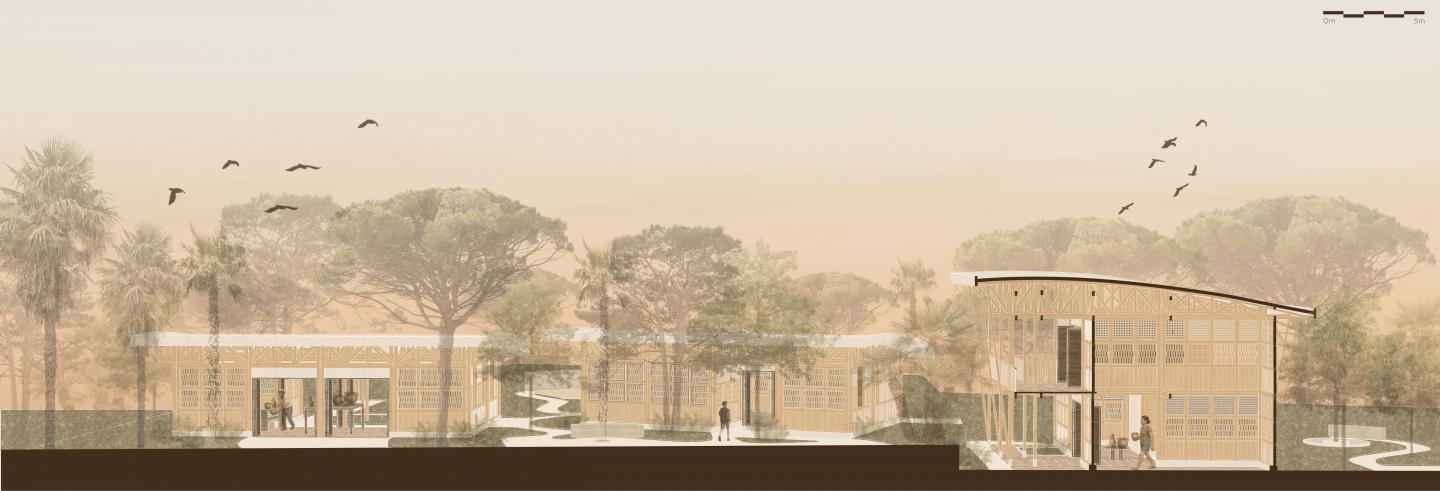The Casa Viva Gathering Center project, located in the rural area of La Chamba, Tolima in Colombia arises from a process of engagement with the local community of artisans. Over a period of eight weeks, conversations were held with various members of the community, along with two field visits to the territory, with the aim of gathering information on everyday dynamics and the cultural practices associated with the craft trade.
Based on the findings from the research phase, a guiding concept was defined for the development of the project, one that responds to the needs, values, and ways of life identified in the local context.
The project is conceived as a space for reconciliation and reconnection with the territory and artisanal knowledge. Its purpose is to foster the strengthening of the social fabric by creating meaningful bonds among community members, promoting intergenerational encounters where younger generations can recognize and value the cultural legacy of their elders thus resignifying the craft trade as a foundational element of identity and local development.
The Casa Viva Gathering Center is structured around three programmatic volumes designed to address the social, cultural, and economic needs of La Chamba community. The first of these spaces is intended for workshops led by local artisans, promoting intergenerational knowledge transfer and reinforcing the craft as both an identity anchor and a productive activity. The second volume is aimed at children and youth from the village, seeking to integrate pottery into their daily lives from an early age and to generate a material and symbolic relationship with clay that allows them to recognize its cultural value and envision its continuity over time. The third volume, which is the central space, is configured as an open area for the exhibition and direct sale of handmade pieces, enabling artisans to sell their work without intermediaries and to dignify their labor before local and foreign audiences.
The project not only follows a programmatic logic but also takes an active stance on the revitalization of public space and the regeneration of social dynamics. Through the careful integration of landscape and architecture, it proposes a sensitive intervention that includes reforestation along the rear edge of the site and the design of a permeable urban front facing the street. This configuration functions as an ecological and social membrane that bridges the natural and urban environments, fostering the community’s reconnection with its immediate surroundings. In this sense, the proposal seeks to reactivate communal bonds through a material connection with the territory, the craft, and nature understanding the regeneration of the social bond as a process deeply tied to the embodied, sensorial, and collective experience of space.
2025
The Casa Viva Gathering Center project is primarily structured using guadua, a vernacular material that not only offers aesthetic and structural qualities but also reinforces the commitment to sustainability and local identity. The project’s envelope is composed of three types of panels that regulate the visual and climatic relationship between the interior and exterior: Fully transparent panels that allow complete openness to the surroundings; semi-transparent panels that filter light and create a more subtle connection with the outside; and opaque panels that provide privacy for certain areas establishing a gradient of transparency according to use and orientation.
Additionally, the design incorporates a passive cross-ventilation system through elevated, semi-curved roofs that promote natural airflow within the volumes, cooling the interior spaces without the need for artificial systems and improving thermal comfort in an efficient manner, aligned with the region’s climate.
Designer: Laura Carbonell Duque
Instructors: Camilo Salazar, Juanita Botero, Raúl Acosta










